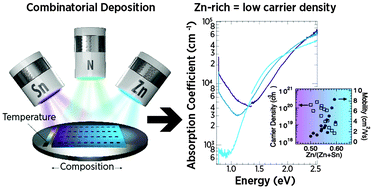Combinatorial insights into doping control and transport properties of zinc tin nitride†
Abstract
ZnSnN2 is an Earth-abundant semiconductor analogous to the III–nitrides with potential as a solar absorber due to its direct bandgap, steep absorption onset, and disorder-driven bandgap tunability. Despite these desirable properties, discrepancies in the fundamental bandgap and degenerate n-type carrier density have been prevalent issues in the limited amount of literature available on this material. Using a combinatorial RF co-sputtering approach, we have explored a growth-temperature-composition space for Zn1+xSn1−xN2 over the ranges 35–340 °C and 0.30–0.75 Zn/(Zn + Sn). In this way, we identified an optimal set of deposition parameters for obtaining as-deposited films with wurtzite crystal structure and carrier density as low as 1.8 × 1018 cm−3. Films grown at 230 °C with Zn/(Zn + Sn) = 0.60 were found to have the largest grain size overall (70 nm diameter on average) while also exhibiting low carrier density (3 × 1018 cm−3) and high mobility (8.3 cm2 V−1 s−1). Using this approach, we establish the direct bandgap of cation-disordered ZnSnN2 at 1.0 eV. Furthermore, we report tunable carrier density as a function of cation composition, in which lower carrier density is observed for higher Zn content. This relationship manifests as a Burstein–Moss shift widening the apparent bandgap as cation composition moves away from Zn-rich. Collectively, these findings provide important insight into the fundamental properties of the Zn–Sn–N material system and highlight the potential to utilize ZnSnN2 for photovoltaics.


 Please wait while we load your content...
Please wait while we load your content...